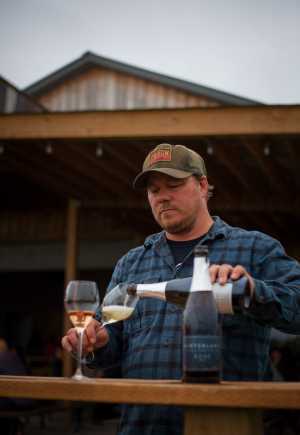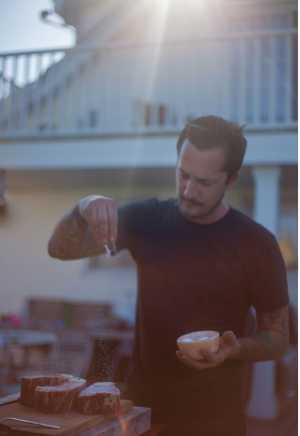Cod cakes and hot sauce. It’s literally the spiciest thing you’ll eat in the County today,” the woman operating a pop-up stand says as she hands me a paper cone stuffed to the top with golf-ball-sized fried croquettes generously covered in a chunky sun-coloured sauce.
We’re standing in the parking lot of a church in the town of Wellington in Prince Edward County. A gentle breeze rolls in from Lake Ontario on a sunny Saturday morning as groups of city slickers rush in. Every Saturday the dreary space blooms into a farmers’ market, a central attraction for anyone in the area, known to locals and visitors as “the County.”
What started as a modest Saturday farmers’ market has now become a hive of food and wine pop-up vendors. When in town, it’s a ritual to visit the Saturday market, even if you’re not shopping for eggs and bread. It’s a good way to ease into one of Ontario’s most popular staycation getaways.
Prince Edward County is located at the midway point of a trip from Toronto to Ottawa. The barely-connected island, with its limestone-rich soil, juts out into Lake Ontario’s northeastern corner. Its modern history dates back to the late 1700s when it became a United Empire Loyalist settlement. Over the last few decades it’s become home to a retirement community and a collective of artists and photographers who seek inspiration from the landscape.
The scenery is a photographer’s dream with wavy roads, towering cliffs and rolling hills giving it a picturesque and calm setting. With hundreds of kilometres of diverse shoreline that shift between cream-coloured, sandy beaches and stretches of turquoise water, it has also become a destination for sunseekers and beach lovers. When you visit the County, pack your bathing gear and visit Sandbanks Dunes Beach. You’ll feel like you’ve been transported out of Ontario.
WITH HUNDREDS OF KILOMETRES OF DIVERSE SHORELINE, PEC HAS BECOME A DESTINATION FOR SUNSEEKERS AND BEACH LOVERS
The town of Wellington has one major road and intersection but it has already sprouted several cafes and restaurants. Wine bar? Check. Third wave cafe? Yup. There’s even a brewery across the street from where the farmers’ market is hosted.
After breakfast, we head out for a wine tour of one of the seven townships that are the County’s antecedents. Our first stop is a tiny boutique winery, tucked in between farms, called Trail Estate.
Mackenzie Brisbois is one of the first winemakers in the County to experiment with orange wine – a natural winemaking technique (no additives) where mashed grapes and juice are left in a large vessel for days, weeks or longer for prolonged skin contact. The process dates back thousands of years to a similar system used in the Caucuses where wines were left to ferment underground in large vessels. For modern-day winemakers, orange wine brings the allure of creating something natural and out of control, perhaps the truest expression of “terroir.”
For Brisbois’s wine, the skin is in contact with the juice for 365 days. It’s an intense wine, crisp at first followed by sourness and funk. It’s unlike anything you’ll taste anywhere else, and she’s only managed to produce 25 cases of it. Brisbois is among a handful of winemakers shaping one of Canada’s quickly growing wine regions. She makes her wine at Trail Estate, a small-scale operation in one of the most interesting pockets of winemaking in the County.
After a quick hike up a dirt road to The Old Third winery, we taste some incredible small-batch pinot noir in a retrofitted barnyard setting. The barn-cum-winery motif is an ongoing trend here and you could easily do a tour of wineries situated in barns.
In the other direction, a country home is the base for estate-made wines by mother-and-daughter winemaking team Caroline Granger and Maggie Belcastro.
At the 14-year-old winery, Grange of P.E.C., Granger and Belcastro make wines exclusively using their own grapes; they grow six different varieties that they believe are suited to the climate of P.E.C. “We’re trying to create wines that speak to the local terroir as much as possible here. My goal is to try to have a very light hand with the winemaking. Let the soil speak, let the climate speak,” Belcastro says.
At Hinterland Wine Company, producers of some of the most complex and layered sparkling wines in Canada, ex-Toronto sommelier Jonas Newman has been crafting premium offerings for nearly a decade using estate grapes. “People in the County, we’ve all come here from the city, either Toronto or Ottawa. Our goal was to see if we can produce sparkling wine and do it really well,” Newman says.
He owns and runs the winery (also in a barn) with his wife Vicki Samaras. Newman’s current flagship product is his method traditional rosé sparkler, which has a creamy and lingering mouthfeel. When you stop by, always try the rosé.
All four of these wineries are within a few kilometres of each other on Closson; they’re practically on one tiny winding dirt road that takes you through an exciting patch of Ontario. With the soil conditions similar to places like Burgundy, winemakers are smitten with the prospect of making cool-climate wines: crisp chardonnays and soil-y pinot noirs that smell like ripe cherries and have a silky texture.
MY GOAL IS TO TRY TO HAVE A VERY LIGHT HAND IN THE WINEMAKING. LET THE SOIL SPEAK, LET THE CLIMATE SPEAK
Even until recently, accommodations and regular dining options were tough to find. But the County’s main attraction is its ability to morph from a collection of sleepy cottage towns to a bustling country getaway from the city. In the last decade there has been a steady boom of wineries that have sprouted from one end of the County to the other, each of them with their individual character and approach to wine.
P.E.C.’s aesthetic is still rustic barnyard compared to other regions in Canada. Facilities are simple, most wineries operate out of barns, some over a hundred years old. Where others have polished wine tasting rooms, the County offers up-close-and-personal settings where the winemaker is almost always present. In some cases, the room you’re tasting that glass of fine chardonnay in doubles as an aging space for the next vintage. There’s something for nearly every palate, from approachable summer quaffers created to soothe a slight sweet tooth to the nerdy, funky tasting, natural wines.
When the popular Drake Hotel opened an offshoot in Wellington in 2014, everything changed. The Village of Wellington is a favourite meeting point in the County for its close proximity to the wine trail and its downtown restaurant row. After the Drake Devonshire opened, staycationers flocked to the County in droves looking for a quick dose of culture, a mix of Toronto hip with cottage country aesthetics. And the well-known chefs quickly followed, too.
More recently, a second wave of Toronto chefs and popups have set up shop next to the greener pastures. This type of restaurant industry exodus isn’t rare: chefs abandon their posts in search of new opportunities regularly. As with each of Manhattan to Hoboken, Seattle to Spokane and San Francisco to Oakland, increased cost of operations and a changing food scene have all helped push the decision forward.
“There’s something very alluring about being out here. It feels like you have a blank slate and the ability to do something new and fresh,” Grant van Gameren says. With eight restaurants under his belt, van Gameren is known for opening one “it spot” after another in downtown Toronto.
Recently he purchased a lakeside cottage in Waupoos, in east Prince Edward County nestled between a cidery and a winery. The 200-year-old, sprawling estate comes with 500 calming feet of lakeside views, an outdoor pool, three fireplaces and a small chardonnay vineyard.
Waupoos, in my opinion, is one of the most beautiful parts of Prince Edward County, an area where it feels like hills slide directly into the lake at points. This is the nature-lover’s dream, equidistant to beaches and wineries but an area that offers as much seclusion as you want. The Cressy Longhouse may be one of the most idyllic places to stay in the area if you’re the kind of vacationer who prefers to stay in rather than do a multi-stop tour of tasting rooms.
Van Gameren has started to rent the property for medium to large-size groups. His property is designed to cater to groups that are looking for the full cottage experience away with the occasional winery jaunt. “It’s quite tranquil out here. We’ve designed the property so that if you don’t want to leave, you don’t have to. There’s a winery literally across the street,” he says. The chef equipped the house with a full range of outdoor grilling gear and guests can hire van Gameren to prepare an outdoor seasonal dinner during their stay.
The seasonal produce in the County is a big attraction for chefs who want to be close to the source of their fresh ingredients. “My eggs are from the farmer next door, the meat is from up the street. And the vegetables are from a few kilometres away,” Hidde Zomer says.
IT’S VERY ALLURING BEING OUT HERE. IT FEELS LIKE YOU HAVE A BLANK SLATE AND THE ABILITY TO DO SOMETHING FRESH
The ex-Toronto chef is putting the finishing touches on his restaurant, Flame and Smith, an ode to outdoor wood-fired cooking. Zomer’s ambitious program will highlight immediate seasonality, and most ingredients come from under 10 kilometres away from the restaurant in Wellington.
There’s also a new boutique hotel opening in a historic heritage site with Albert Ponzo, another Toronto chef, at the helm. In 2017, Ponzo left his position as the acclaimed head chef at Le Sélect and is currently waiting for the Royal Hotel to finish construction. Ponzo’s cooking is a balanced mix of French and Italian.
The County’s fertile winery and market options also help support a growing number of food pop-ups. During the weekends, it’s not hard to spot a Jamaican truck that specializes in traditional pimento-wood-smoked jerk chicken or that Bajan stand serving cones of fried cod croquettes with house-made scotch bonnet hot sauce.
After running restaurants in Toronto for over 30 years and laying the groundwork for Toronto’s modern dining scene with highly acclaimed restaurants, Jamie Kennedy moved back to the County a few years ago. At his 100-acre farm, he continues his plot-to-table philosophy with winemaker dinners and other food events.
He also has a quaint Airbnb rental called The White House. Designed to host up to eight guests, it’s a quick drive to the Closson Road wine row. Kennedy is currently working on an exciting wine-focussed culinary project with a hint of nostalgia, and in the meantime operates a fry stand with his son at the weekend farmer’s market in Wellington.
“The County has evolved so quickly in such a short amount of time, but it has mostly managed to maintain its character. The qualities of the city blend into the cottage country aesthetics, and with all this talent pouring in, it has become an exciting place,” Kennedy says.


